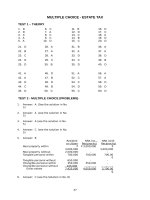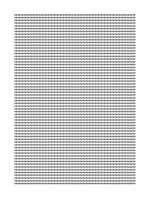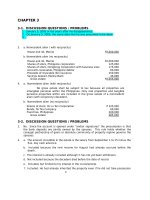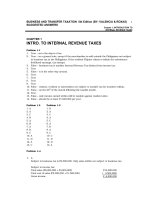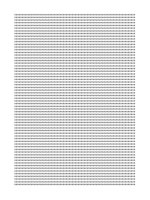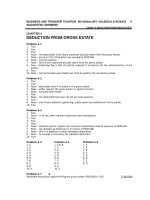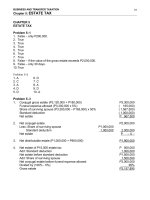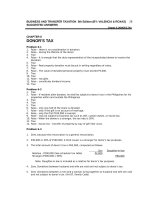Solution manual transfer and business taxes by valencia CHAPTER 13 LOCAL TAX
Bạn đang xem bản rút gọn của tài liệu. Xem và tải ngay bản đầy đủ của tài liệu tại đây (59.83 KB, 5 trang )
BUSINESS AND TRANSFER TAXATION 5th Edition (BY: VALENCIA & ROXAS)
SUGGESTED ANSWERS
68
Chapter 13: LOCAL TAX
CHAPTER 13
LOCAL TAXES
Problem 13–1
1. True
2. True
3. False – Subject to final approval of the executive.
4. False – cities
5. True
6. True
7. False – Only if employed, doing business or owner of real properties
8. True
9. False – Additional should be based on gross receipts.
10. False – P10,000.
Problem 13–2
1. True
2. True
3. True
4. True
5. True
6. True
7. True
8. False – Assessed value.
9. True
10. True
Problem 13–3
1. A
5. D
2. D
6. D
3. D
7. D
4. A
8. D
Problem 13–4
Case 1:
The administrative order is not enforceable because such is not covered by any city tax
ordinance.
Case 2:
The tax ordinance is still unenforceable because of the lack of required public hearing.
Case 3:
No, because the issue does not involve the tax liability of the taxpayer, but the authority of
the enforcing government unit. The ambiguity of power to tax is to be resolved liberally in
favor of the taxing authority.
Case 4:
No, because with regards to exemption, the burden of proof must be on the part of the
taxpayer.
BUSINESS AND TRANSFER TAXATION 5th Edition (BY: VALENCIA & ROXAS)
SUGGESTED ANSWERS
69
Chapter 13: LOCAL TAX
Case 5:
No. Although appropriately exercised by the Sanggunian (legislative branch), it will still
need the approval of the mayor or provincial governor (executive branch)
Problem 13–5
Case 1:
Taxable base, (higher value)
Multiply by tax rate
Tax on transfer - amount payable by Mon Ting
P 600,000
0.5%
P
3,000
Case 2:
There is no transfer or ownership tax because the land is intended as a site for personal
residence. Real property for the purpose of this tax refers only to land, building and
machineries intended by the owner for an industry or which tend directly to meet the
needs of the said industry or work. (Sec. 135, LGC)
Problem 13–6
Taxable base
Multiply by tax rate
Printing and Publication tax
P 200,000
0.5%
P
1,000
Problem 13–7
1
Total collections
.
Less: Receipts from the government (P1,000,000 x 50%)
Balance
Multiplied by
Local tax payable
2
.
P4,000,000
500,000
P3,500,000
0.005
P
17,500
Basic
P
Additional community tax:
Gross receipts (P4,000,000/P1,000) x P1
Total community tax
5
4,000
P4,005
Problem 13–8
1
.
2
.
Total market value
P6,000,000
Multiplied by provincial tax rate
Provincial tax
10%
P 600,000
Basic
Additional community tax:
Gross receipts (P9,000,000/P5,000) x P2
Market value of real property (assumed as the assessed value)
(P20,000,000/P5,000) x P2
Total community tax
P
500
P3,600
8,000
10,000
P10,500
Problem 13–9
1
P50 annually.
.
2
.
Basic
P 5.00
BUSINESS AND TRANSFER TAXATION 5th Edition (BY: VALENCIA & ROXAS)
SUGGESTED ANSWERS
70
Chapter 13: LOCAL TAX
Additional [ (P150 x 365) /1,000] x P1.00
Total community tax
54.75
P59.75
Problem 13–10
Local tax per unit
Multiply by number of vans maintained
Total local tax for the delivery van
Problem 13–11
Case 1:
1
Taxable base
.
Multiplied by tax rate bracket
Municipal business tax
2
.
P
500
5
P 2,500
P1,500,000
0.25%
3,750
P
Taxable base
P 600,000
Multiplied by tax rate bracket
Municipal business tax
P
0.5%
3,000
Case 2:
None, because his business tax is payable to the barangay in as much as his sales is lesser
than P30,000. In that case, the barangay has the exclusive power to levy the local business
tax. (Sec. 152, LGC)
Problem 13–12
Case 1:
No, because the imposition is not in excess of what is provided in the Code. What is
allowed in the province is ½ of 1% of the total consideration for the transfer of Real
Property.
The maximum that is allowed for the city is an increase of not more than 50% of what is
allowed for the province or municipalities, thus the maximum could be tabulated as:
Provincial rate
Maximum percent increase
Effective % increase
Add: the basic rate for the province
Maximum rate that a city could impose*
0.50%
50%
0.25%
0.50%
0.75%
*0.75% is the same as ¾ of 1%.
Case 2:
No, because the imposition is not in excess of what is provided in the Code. The allowed
minimum tax per year in municipalities is P165 of which a maximum of 50% increase is
allowed to compute the tax for the cities. Thus, the computation would be:
Minimum tax in municipalities per year
Add: Maximum increase allowed (P165 x 50%)
Maximum allowed for the cities
P165.00
82.50
P247.50
BUSINESS AND TRANSFER TAXATION 5th Edition (BY: VALENCIA & ROXAS)
SUGGESTED ANSWERS
71
Chapter 13: LOCAL TAX
Case 3:
Yes. The city is only allowed of 30% maximum of what is allowed to the province.
Amusement and professional taxes are not included in the allowed 50% increase a city
could make above the province and the municipality could legally impose.
Case 4:
The retailer should be paying only his business tax to barangay, computed as follows:
Gross receipts
Multiply by rate of tax
Business tax to the barangay
P40,000
2%
P
800
The retailer is no longer required to pay to the city because its gross receipts is not
exceeding P50,000 per year.
Problem 13–13
Case 1:
The community tax of AWAN Corporation should be paid on or before February 28, 2005.
The amount of community tax to be paid is P500.
Case 2:
Basic
Additional community tax (P200,000/1,000) x P1
Total
Add: Surcharge P205 x 25%)
Interest (P205 x 2% x 2 mos.)
Total community tax
P 5.00
200.00
P205.00
51.25
8.20
P264.45
Problem 13–14
Case 1:
Yes. Engr. Kitik is required to pay a professional tax because any professional, signing a
document in the exercise of his profession is required to indicate the PTR (professional tax
receipt) number on the document he is signing or certifying.
Case 2:
Mr. Max Cuenta need not obtain a PTR in Makati because a person who has paid the
corresponding professional tax shall be entitled to practice his profession in any part of the
Philippines.
Case 3:
Mr. Ado will have to pay P150 for his profession as CPA and another P150 for his profession
as a Lawyer.
Problem 13–15
Assume that the fair value is equal to assessed value.
Basic (P600,000 x 1%)
Additional tax on idle lands (P600,000 x 5%)
Total amount
Problem 13–16
P 6,000
30,000
P36,000
BUSINESS AND TRANSFER TAXATION 5th Edition (BY: VALENCIA & ROXAS)
SUGGESTED ANSWERS
72
Chapter 13: LOCAL TAX
X’s total fees and taxes in order to obtain a business permit would be P2,000, computed as
follows:
Mayor’s permit
Local business tax (P150,000 x 1%)
Total fees and taxes
P 500
1,500
P2,000


